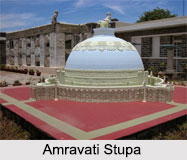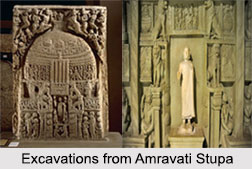 Amravati Stupa is a ruined Buddhist stupa which is popularly known as the great stupa of Amravathi. This stupa, situated at the Amravathi village of Guntur district in Andhra Pradesh, was built in the period of 3rd century BCE and 250 CE. During the decline of Buddhism the Amravati Stupa was excavated under rubble. But according to an inscription of 14th century, it was rebuilt. The entire campus is currently under the supervision of the Archeological Survey of India.
Amravati Stupa is a ruined Buddhist stupa which is popularly known as the great stupa of Amravathi. This stupa, situated at the Amravathi village of Guntur district in Andhra Pradesh, was built in the period of 3rd century BCE and 250 CE. During the decline of Buddhism the Amravati Stupa was excavated under rubble. But according to an inscription of 14th century, it was rebuilt. The entire campus is currently under the supervision of the Archeological Survey of India.
History of Amravati Stupa
From the old inscriptions, it can be noticed that the stupa was marked as the dipaldimma or the hill of lights. In the ancient era, the stupa was called Mahachaitya Stupa or the great sanctuary, rather than Amravati Stupa.
It is mostly said that the stupa was probably founded in the 3rd century BCE in the reign of Ashoka. But there is no clear evidence of this foundation time. Though the foundation period was mentioned in the earliest inscription of this site, yet it cannot be associated with Ashoka.
The construction period of Amravati Stupa is mainly divided into two phases- early period of construction and late period of construction. The early period is circa 200-100 BCE. The late period comes under three phases- first phase 50-0 CE, second phase 50-100 CE and third phase 200-250 CE.
Structure of Amravati Stupa
The later construction of Amravati Stupa is comprising of railings and carved slabs set around the stupa. These carved slabs are generally called drum slabs since they were put round the base of the stupa which has a shape similar to a circular drum. In the early period the stupa had a basic railing comprising of granite pillars, with coping stones and plain cross-bars. The coping stones with youths and creature salvation, the early drum slabs, and some other early portions, have a place in this period. Examined the granite pillars, it is assumed that the Amravati Stupa might be large enough at that period of time.
 Recovery of Amravati Stupa
Recovery of Amravati Stupa
The ruins of the Amravati Stupa were first discovered by Major Colin Mackenzie in 1797 on the right bank of the Krishna River. During his excavation most of the structure got destroyed and the bricks had been used to make local houses. But he made his further excavation and recorded a plan of the Amravati Stupa.
In 1845, Sir Walter Elliot of Madras Civil Service again went to the spot and excavated near the west gate of the railing. He was able to bring out some sculptures from his excavations which were then moved to Madras Museum (now Chennai).The sculptures then were exported to London in 1859. The photographs and sketches made out of Sir Walters"s artifacts are called Elliot Marbles. Robert Sewell further started a new excavation in 1880 and recorded all his notes and drawings in details.
The sculptures, still in India, are getting damaged due to the atmosphere and salt in the air for not being put in an air-conditioned place. Chennai Museum is yet to put them in an air-conditioned room for complete restoration.
Sculptures of Amravati Stupa
Amravati Stupa was decorated with carvings of the life and teachings of Lord Buddha. It also narrates the events of Jataka Stories. The Amravati Stupa is also related to the Vajrayana teachings of Kalachakra. According to some art historians, the Amravati art is one of the three major schools of ancient Indian art. The other two schools of art are Mathura style and Gandhara style.
The unearthed sculptures of the stupa depict Lord Buddha in a human form subduing an elephant. When the Amravati Stupa had been renovated by the Satavahana rulers, it became a marked architectural monument.
Restoration of Amravati Sculptures
All of the sculptures have been removed from the spot of Amravati Stupa, although few broken pillars still remain in it. The remarkable sculptures unearthed from this site are now in many museums of India and abroad as well.



















